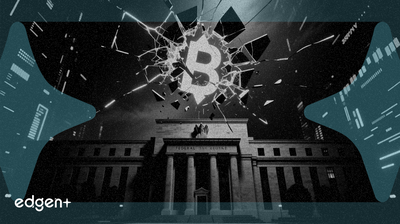 报告
报告
No Data Yet
相关新闻

美联储利率决议后,BNB跌破865美元
## 执行摘要 本报告分析了在美国联邦储备委员会最新货币政策决定后 **BNB** 的价格下跌。联邦公开市场委员会(FOMC)实施了25个基点的降息,将联邦基金利率目标范围降至3.5%至3.75%。作为回应,**BNB** 经历了2.7%的跌幅至865美元,反映了加密货币市场的普遍低迷。该事件强调了该资产对宏观经济信号的敏感性,并将其置于关键的技术支撑位。尽管总体情绪看跌,但更广泛的数字资产生态系统正在出现分歧迹象,大量机构资本通过新批准的交易所交易基金(ETF)流入 **XRP** 等特定资产,这表明市场格局更加细致和成熟。 ## 事件详情 联邦储备委员会结束了其2025年12月的会议,实施了连续第三次25个基点的降息。尽管这一决定被期货市场以89%的可能性广泛预期,但并非一致通过。九名联邦公开市场委员会成员投票支持降息,两名投票支持维持利率不变,一名投票支持更激进的50个基点降息。在其官方声明中,委员会指出,虽然经济活动正在以“温和速度”扩张,但就业风险已经上升。 宣布后,**BNB** 立即录得2.7%的急剧下跌,跌破865美元大关。该代币目前在一个狭窄范围内交易,技术分析表明在864-867美元的支撑区域有强大的买方防御。相反,卖方已在868.50美元附近建立了一个上限,形成了紧密的盘整模式。未能收复874美元上方的水平可能确认看跌前景,并为进一步的价格贬值打开大门。 ## 市场影响 美联储的决定引发了传统市场的可预测走势,包括美元下跌。然而,对数字资产的影响不那么统一。对于 **BNB** 而言,直接影响是负面的,使其与普遍的市场回调保持一致。需要关注的关键技术水平是864美元附近的支撑区域;突破该水平可能导致价格跌向下一个重要支撑位,约为839美元。 这一价格走势与加密货币领域其他地方的发展形成鲜明对比。例如,美国现货 **XRP** ETF已连续16天录得资金流入,使其总资产管理规模突破10亿美元大关。这种分歧突显了一个关键主题:加密货币市场不再是铁板一块。虽然美联储政策等宏观经济因素仍然具有影响力,但资产特定的驱动因素,如监管清晰度——就 **XRP** 而言,是与SEC诉讼的结束——正在使某些资产在机构采用的推动下走出自己的道路。 ## 专家评论 虽然关于 **BNB** 的具体评论有限,但对更广泛市场的分析提供了背景。高盛分析师曾预计美联储主席杰罗姆·鲍威尔将暗示未来降息的门槛更高,这一情绪加剧了市场谨慎。Kitco的技术分析指出,加密货币总市值正在测试一个关键的上方阻力位,尽管一些山寨币显示出看涨背离,但总体趋势仍是盘整。 此外,**以太坊(ETH)** 相对于 **比特币(BTC)** 的出色表现,ETH/BTC比率上涨,表明资本轮动正在进行。正如Kitco的一份报告所述: > “这一转变证实了以太坊在本轮周期中的领导地位,并增强了更广泛的山寨币走强的理由。” 这种环境意味着,即使宏观逆风给更广泛的市场指数带来压力,具有强大基本面叙事或技术设置的代币仍可能吸引资本。 ## 更广泛的背景 美联储降息是在重大的经济不确定性中进行的,近期政府停摆进一步加剧了这种不确定性,导致关键通胀和就业数据延迟发布。这迫使中央银行根据不完整的信息制定政策,从而加剧了市场焦虑。 **BNB** 的同步疲软以及机构支持产品如 **XRP** 和 **Solana (SOL)** ETF 的强劲表现,标志着一个日益成熟的金融生态系统。投资者越来越有辨别力,根据特定的用例、监管地位以及通过传统金融工具的访问来配置资本。整个加密货币市场与 **比特币** 或宏观经济新闻同步波动的时代似乎正在衰退,取而代之的是一个更加碎片化的格局,其中个体资产表现受到技术、采用和机构访问等多种因素的共同驱动。因此,**BNB** 的价格表现不能孤立地看待,而是复杂且日益成熟的市场的一部分。

ICP跌破支撑位,市场静待美联储决议
## 执行摘要 2025年12月11日,**互联网计算机(ICP)**代币经历了重大的技术性崩溃,其价格从3.52美元跌至3.37美元,跌幅达4.28%。此举突破了关键的3.40美元支撑位,预示着其看跌市场结构的强化。此次下跌发生在全球投资者等待美国联邦储备理事会即将召开的政策会议结果之际,会议普遍预期将降息。 ## 事件详情 **ICP**的价格走势表现为果断跌破被认为是关键支撑区域的水平。短期反弹至3.60美元遭遇交易量大幅飙升,这证实了该水平是一个强大的阻力点。随后未能守住3.40美元的水平表明存在强大的抛售压力。当前的即时技术前景取决于该代币能否收复该区域;如果未能做到,则预示着价格可能进一步恶化。 ## 市场影响 跌破3.40美元使**ICP**处于岌岌可危的境地。下一个可识别的支撑结构在3.33美元至3.35美元区间。未能守住这一水平可能引发对更深层支撑区域的重新测试。这种看跌表现与更广泛的加密货币市场明显背离。**比特币(BTC)**表现出看涨盘整的迹象,而**以太坊(ETH)**表现出相当大的优异表现,这表明资金可能正在转向市场领导者。**ICP**的疲软似乎是孤立的,并且基于其自身的技术因素而非市场范围的下滑。 ## 专家评论 市场分析表明,主要资产正在为联邦储备理事会的鸽派政策转变做准备。根据**KITCO**的报告,**比特币**的链上交易量指标表明购买压力增加,而**以太坊**相对于**比特币(ETH/BTC)**的优异表现则表明其在当前市场周期中新兴的领导地位。**星展银行(DBS Bank)**及其他分析师指出,美联储降息是可能为风险资产提供支持的关键宏观驱动因素。这种背景使得ICP的同期疲软成为一个显著的异类,可能由在既定阻力位获利了结所驱动。 ## 更广泛的背景 金融市场普遍关注即将到来的联邦公开市场委员会(FOMC)的决定。降息通常对无收益资产和风险资产都是利好。这种情绪反映在贵金属市场中,**白银**在对货币宽松和基本供应短缺的投机性押注下飙升至每盎司61美元以上的历史新高。同样,**黄金**仍处于紧密的看涨盘整模式。ICP的价格下跌与这种普遍的宏观经济叙事背道而驰,这突出表明代币特定的技术和情绪有时甚至可以超越强大的市场范围催化剂。

Bubblemaps数据揭露PEPE内幕钱包活动
## 执行摘要 区块链分析公司**Bubblemaps**揭露了与**PEPE**迷因币相关的重大内部人士活动,挑战了其“公平发行”的说法。分析显示,该代币创世供应量的30%集中在一个相互关联的钱包集群中,该集群在其公开发布后不久出售了价值200万美元的**PEPE**。这一披露引发了显著的看跌情绪,影响了代币价格,并引发了对迷因币市场透明度的广泛质疑。 ## 事件详情 根据**Bubblemaps**提供的数据,**PEPE**的发布并不像声称的那样去中心化。核心发现集中在链上证据,表明一小部分协调的内部人士持有大部分初始供应。 - **创世供应集中:** 推出时创建的总代币中约30%被发送到特定钱包组。 - **相互关联的钱包:** 链上取证显示,这些钱包并非独立参与者,而是关联集群的一部分,表明一个单一实体或一个小型协调小组在控制。 - **快速清算:** **PEPE**发布并公开交易的第二天,该钱包集群执行了价值200万美元的销售。这种快速清算表明,其策略是利用最初的散户驱动的价格上涨。 这些行为直接与“公平发行”原则相悖,该术语意味着公平分配,没有预挖代币或为内部人士提供优惠分配。 ## 市场影响 此次披露对**PEPE**及周边市场产生了直接且负面的影响。消息传出后,该代币价格下跌6.65%,反映出投资者信心急剧下降。对于一个主要价值来源于社区信任和叙事力量的迷因币而言,这样的披露可能特别具有破坏性。该事件还带来了监管审查增加的风险,因为协调的内部人士销售常常会引起关注市场操纵的金融当局的注意。 从技术角度来看,市场表现出显著波动。尽管一些指标,例如4小时TBO突破,表明短期交易机会,但整体情绪已转为看跌。此次事件突显了很大程度上不受监管的迷因币行业固有的风险,在该行业中,项目声明往往未经核实。 ## 专家评论 虽然目前尚未有针对**PEPE**事件的具体专家评论,但该事件符合行业日益增长的对更高透明度和打击市场操纵工具的需求。**DeepSnitch AI (DSNT)**等链上智能平台的出现,旨在检测内部交易和“拉地毯”等可疑活动,凸显了这一趋势。根据《论坛报》的一篇报道,此类工具正在获得关注,作为对加密市场“被操纵游戏”看法的回应。**Bubblemaps**等公司揭露这些活动的能力为交易者提供了风险评估的关键数据,这是投机市场中以前无法实现的功能。 ## 更广泛的背景 此事件是加密货币领域正在发生的更大结构性转变的缩影。它展示了链上分析在强制问责制和揭示营销叙事面纱方面的日益强大的力量。盲目接受“公平发行”声明的时代正在消退,取而代之的是数据驱动的方法,投资者可以验证代币分配和钱包活动。 **PEPE**内部人士清算事件是投机性、叙事驱动型资产相关风险的明确案例研究。它强调了尽职调查的重要性,并突出了一项关键的市场演变:加密分析的专业化。随着更多资金流入数字资产领域,对能够区分合法项目和集中内部人士持有项目的工具的需求预计将增长,这可能使市场成熟并为散户参与者提供更大的保护。

Pepe 网站遭黑客攻击,用户被重定向至恶意软件
## 执行摘要 **Pepe** 迷因币的官方网站已在一次重大安全漏洞中遭到入侵。攻击者篡改了该网站,将毫无戒心的用户重定向到部署 **Inferno Drainer** 恶意软件的恶意链接,该脚本旨在清空受害者加密货币钱包中的资产。此次事件使代币持有者面临直接的财务损失,并严重打击了项目的声誉,凸显了迷因币领域固有的运营风险。 ## 事件详情 此次攻击涉及未经授权修改官方 **Pepe** 项目网站,该网站是社区更新和信息的中心枢纽。网站上的链接被重定向到一个托管 **Inferno Drainer** 脚本的钓鱼门户,而不是合法的资源。这种被称为钱包耗尽器的恶意软件会诱骗用户批准恶意交易。一旦获得授权,该脚本会自动将所有数字资产,包括加密货币和 NFT,从受害者的钱包转移到攻击者控制的地址。根据网络安全情报,像 Inferno 这样的耗尽器工具在加密领域很普遍,已从用户那里窃取了数百万美元。 ## 市场影响 此次漏洞对 **PEPE** 代币带来了显著的看跌压力。对于迷因币而言,其价值几乎完全来源于社区情绪和投机兴趣,信任的丧失可能是灾难性的。此次事件直接威胁到其持有者的资产,为投资者抛售创造了明确的动机。此类安全故障通常会导致价格急剧下跌和持续的负面市场情绪,因为交易者会质疑该项目匿名开发团队的运营安全性和长期可行性。此次攻击危及了该币已经脆弱的信誉,并可能阻止新资金进入其生态系统。 ## 专家评论 网络安全分析师一再警告钱包耗尽器计划的兴起。根据 Check Point Research 和 Infosecurity Magazine 等公司的研究,这些攻击变得越来越复杂。在过去一年中,钱包耗尽器造成了约 5 亿美元的损失。一份关于 **Inferno Drainer** 卷土重来的报告指出,它在执行快速、广泛的加密钱包盗窃方面的有效性。安全专家强调,核心问题不总是复杂的智能合约漏洞,而往往是基本网络基础设施安全方面的失败,如此案例所示。正如对另一次复杂的去中心化金融漏洞的分析所指出的,“复杂系统中的正确性需要明确处理所有状态转换,而不仅仅是‘快乐路径’”,这一原则同样适用于面向用户的网络平台的安全性。 ## 更广泛的背景 **Pepe** 网站遭到黑客攻击并非孤立事件,而是反映了 Web3 领域持续存在的安全漏洞模式。它与许多其他事件如出一辙,攻击者将目标对准了项目安全链中最薄弱的环节——其面向公众的基础设施。从 DeFi 协议中的漏洞,如 900 万美元的 **Yearn Finance** yETH 池漏洞,到利用恶意浏览器扩展程序的广泛恶意软件活动,加密投资者的攻击面是巨大的。此次事件是一个严峻的提醒,即使是市值巨大的项目也可能容易受到基本的网络攻击,从而损害信任并阻碍数字资产被主流用户更广泛地采用。